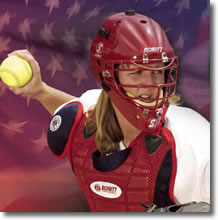Joe Garagiola of the Pittsburgh Pirates once said, “The wind always seems to blow against catchers when they’re running.” Well Joe, not anymore!

Today’s catchers are leaner and quicker then ever. Just take a look at the catchers representing the U.S. Olympic Team and you will see the new breed of athlete behind the plate.
When I go recruiting for the University of Arkansas and am looking for a good young catcher, the first thing I take notice of is her quickness. Quickness can make up for a whole lot of negatives. For instance, a quick release can make up for a weak arm. Quickness “out of the shoot” or from behind the plate allow your corners to stay back an extra step, cutting off the base hit. Quick fast-twitch muscle fibers mean fewer passed balls. Plus, there is a certain mentality that goes with a quick player behind the plate, aggressiveness.
Developing quickness can be done a number of ways. The following are three drills I have adapted to fit the needs of myself and the players I coach. It is important to realize, most of the drills we implement as coaches, are just that, adaptations of someone else’s ideas. These drills were picked up from just about everywhere, from high school, to college, to Olympic level ball, and can be used at any level.
Coming Out of “The Shoot” Quickly
When developing quickness from behind the plate, one of the things I was always told was to be a ballhog. When you have a very competitive player as a catcher, it’s easy to make a game out of getting to bunts quickly.
There is no way a corner was going to beat me to a bunt. One of the drills you can use to develop quickness in your catcher goes as follows: Putting your catcher in her defensive position, have a coach or another player roll a ball from behind her. As quick as she can and moving as low as she can to the ground, have her field the ball correctly rounded to the base being thrown to and complete the play.
Continue in sets of five to ten depending on her endurance. The nice thing about rolling balls from behind, is the catcher does not know where or when it is coming.
The important thing here is to emphasize short, quick steps and to round the ball completely to the base being thrown. Again, make sure she stays low to the ground; you want to cut down on the time it takes her to stand completely up, run to the ball and bend all the way down to field it. This drill will not only help with quickness, but also endurance.
The Wall Drill
One of the drills I picked up from high school, that last year we adapted to the quicker pitching of college ball at the University of South Carolina, is called the “Wall Drill.” This drill develops correct blocking skills by over-emphasizing mechanics and quickness. Situate your catcher, fully geared in her catching position, four or five feet away from a wall. A coach or player then throws a ball from behind the catcher off the wall bouncing it off the ground, simulating a wild pitch. As the catcher improves, have her move closer to the wall. To make the drill a little difficult, instead of a softball try a tennis ball, racquetball, or big super-ball. These balls bounce much quicker and really train the catcher to round her shoulders to keep the ball from rebounding off to the side.
The Quick Release
One of the ways I learned to develop a quick release in a questionable arm was by throwing footballs to second base from the catching position. First, the catcher must catch the ball with both hands, cutting down on the time it takes to catch the ball with one hand and join-up with the throwing hand at a later time. Second, because the female hands are generally smaller, by throwing a football they cannot make a large arm circle or they will lose the grip and drop the ball.
Instead, they have to make a small circle right around the ear with both hands. Without the large arm-circle, emphasize complete rotation of the shoulders and a strong forearm snap. One thing to look out for in this drill is the curveball throw. When throwing a football, females have a tendency to implement an overhand curveball motion leading with their elbow. You want to emphasize a complete downward wrist snap off an over-the-top throw. This is a great drill to develop self-body awareness in your athlete. The better she understands why she is doing something and the way the correct motion feels, the easier she can adjust herself.
These are just three of the drills we have used to improve the quickness in our catchers. There are also numerous drills we have used to develop fast-twitch muscle movements and better hand-eye coordination for all of our players. Again, these drills can be used at any level by any type of player. Developing quickness in your catchers will not only lead t faster games but fewer ulcers with runners on base.